With all the interest in electric, plug-in electric, hybrid electric and hybrid vehicles, perhaps it is time to take a step back and just look what all these names mean. They are not all the same, yet some different technologies share the same names and sometimes similar technologies use different names. A lot of it seems to depend on the marketing the manufacturers are using for a vehicle, so let’s try to clear up some of the confusion surrounding types of systems and terminology when it comes to alternate energy sources for vehicles.
First, the term Hybrid can have several meanings. It could even be a conventional engine that uses two different types of fuel such as gasoline and natural gas, although popular use lately has been referring to these as bi-fuel vehicles. When most people hear “hybrid”, they think of gasoline/electric combined powertrains – Toyota’s Prius is the most recognizable symbol of this technology.

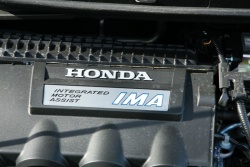
2008 Saturn Vue Green Line, top photo; 2010 Honda Insight, photo by James Bergeron. Click image to enlarge You may here the term “mild hybrid”. This was made popular with the introduction of the Saturn Vue hybrid and is now used on the Chevrolet Malibu Hybrid. This system uses an electric motor/generator that bolts onto the engine in place of the conventional charging system. During acceleration, the unit adds power to the conventional gas engine and during deceleration, the unit becomes a drivetrain-driven generator to recharge the auxiliary battery pack. Much of the fuel economy savings from any hybrid system come from the energy during vehicle deceleration by the generator unit.
Another major feature of hybrids is their ability to stop the gasoline engine while the vehicle is sitting at a stop light and then restart it again instantly when the driver wants to move the vehicle. Even the mild hybrids have this capability to save fuel.
Some vehicles use what may be called a “medium” hybrid system, such as the Honda Civic or Insight, although you won’t hear Honda referring to it with that term. Honda calls it an Integrated Motor Assist, where the electric motor is used in place of the flywheel in a conventional transmission. This electric motor can assist the gas engine during acceleration and recharge the battery pack during deceleration just like the mild hybrids but does so much more efficiently and provides more power. Honda has made many improvements on the system since it was first introduced over a decade ago and when combined with intelligent valve control systems, is now almost equal to what we traditionally call a “full hybrid.”
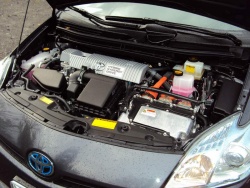
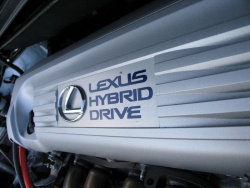
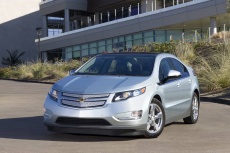
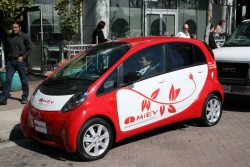
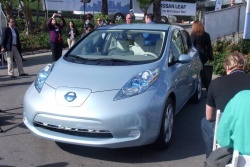
2010 Toyota Prius, top photo, by Chris Chase; 2010 Lexus HS 250h, photo by Haney Louka; 2011 Chevrolet Volt; Mitsubishi iMiev, photo by Bob McHugh; Nissan LEAF, photo by Paul Williams. Click image to enlarge Toyota’s Prius is the best known example of a “full hybrid,” a vehicle that can operate on electric power alone for some distance. It does this with a transmission that contains two motor/generator units. The design of this transmission allows the engine to remain off while one electric motor moves the vehicle. If you need more power or the battery charge is low, the gas engine will also start up to work in combination with the electric motors. Today several vehicles use a hybrid system that will operate on electric power by itself. Toyota has the Prius, Camry and Highlander, while Lexus has a full range of hybrids. Ford has the Escape and Fusion Hybrids, while GM and Dodge are using a similar system in rear wheel drive configuration in their hybrid sport utilities. GM also is using it in pickup models.
The yet to be produced Chevy Volt is also a hybrid but with a different concept. This vehicle operates on electric power all the time. When the battery pack becomes discharged, a small gas engine turns on to operate a generator, which recharges the battery pack. The gas engine never directly powers the wheels, yet this vehicle is also considered a hybrid.
Plug-in Hybrid is a new term, where the vehicle can be recharged by plugging it in to either 110-volt of 220-volt electrical outlets. This type of vehicle will operate on electric power most of the time but could still use a gas engine to supply energy for extended trips.
Electric vehicles are just what the name sounds like. They operate on Electric power only. Golf carts are a popular example, but several manufacturers are introducing electric passenger vehicles such as the Nissan Leaf or the Mitsubishi iMIEV. Toyota has announced plans for a fully electric small car similar to the FT-EV2 concept car will go on sale in 2012. Recharging these vehicles at home or work will become common practice, although already MacDonalds has announce they will offer free-to-use charging stations at some facilities and already opened the first one this past July in the U.S. In Japan, they are already working on infrastructure for electric car battery swap stations, where you pull in and exchange your leased battery for another in less time than it takes to fill a conventional car with gasoline.
While conventional gasoline powered vehicles will still dominate the marketplace for a long time, there are alternatives on the marketplace, and that is good for the future of the automobile.
Jim Kerr is a master automotive mechanic and teaches automotive technology. He has been writing automotive articles for fifteen years for newspapers and magazines in Canada and the United States, and is a member of the Automobile Journalists Association of Canada (AJAC).
canadiandriver.com
First, the term Hybrid can have several meanings. It could even be a conventional engine that uses two different types of fuel such as gasoline and natural gas, although popular use lately has been referring to these as bi-fuel vehicles. When most people hear “hybrid”, they think of gasoline/electric combined powertrains – Toyota’s Prius is the most recognizable symbol of this technology.


2008 Saturn Vue Green Line, top photo; 2010 Honda Insight, photo by James Bergeron. Click image to enlarge You may here the term “mild hybrid”. This was made popular with the introduction of the Saturn Vue hybrid and is now used on the Chevrolet Malibu Hybrid. This system uses an electric motor/generator that bolts onto the engine in place of the conventional charging system. During acceleration, the unit adds power to the conventional gas engine and during deceleration, the unit becomes a drivetrain-driven generator to recharge the auxiliary battery pack. Much of the fuel economy savings from any hybrid system come from the energy during vehicle deceleration by the generator unit.
Another major feature of hybrids is their ability to stop the gasoline engine while the vehicle is sitting at a stop light and then restart it again instantly when the driver wants to move the vehicle. Even the mild hybrids have this capability to save fuel.
Some vehicles use what may be called a “medium” hybrid system, such as the Honda Civic or Insight, although you won’t hear Honda referring to it with that term. Honda calls it an Integrated Motor Assist, where the electric motor is used in place of the flywheel in a conventional transmission. This electric motor can assist the gas engine during acceleration and recharge the battery pack during deceleration just like the mild hybrids but does so much more efficiently and provides more power. Honda has made many improvements on the system since it was first introduced over a decade ago and when combined with intelligent valve control systems, is now almost equal to what we traditionally call a “full hybrid.”





2010 Toyota Prius, top photo, by Chris Chase; 2010 Lexus HS 250h, photo by Haney Louka; 2011 Chevrolet Volt; Mitsubishi iMiev, photo by Bob McHugh; Nissan LEAF, photo by Paul Williams. Click image to enlarge Toyota’s Prius is the best known example of a “full hybrid,” a vehicle that can operate on electric power alone for some distance. It does this with a transmission that contains two motor/generator units. The design of this transmission allows the engine to remain off while one electric motor moves the vehicle. If you need more power or the battery charge is low, the gas engine will also start up to work in combination with the electric motors. Today several vehicles use a hybrid system that will operate on electric power by itself. Toyota has the Prius, Camry and Highlander, while Lexus has a full range of hybrids. Ford has the Escape and Fusion Hybrids, while GM and Dodge are using a similar system in rear wheel drive configuration in their hybrid sport utilities. GM also is using it in pickup models.
The yet to be produced Chevy Volt is also a hybrid but with a different concept. This vehicle operates on electric power all the time. When the battery pack becomes discharged, a small gas engine turns on to operate a generator, which recharges the battery pack. The gas engine never directly powers the wheels, yet this vehicle is also considered a hybrid.
Plug-in Hybrid is a new term, where the vehicle can be recharged by plugging it in to either 110-volt of 220-volt electrical outlets. This type of vehicle will operate on electric power most of the time but could still use a gas engine to supply energy for extended trips.
Electric vehicles are just what the name sounds like. They operate on Electric power only. Golf carts are a popular example, but several manufacturers are introducing electric passenger vehicles such as the Nissan Leaf or the Mitsubishi iMIEV. Toyota has announced plans for a fully electric small car similar to the FT-EV2 concept car will go on sale in 2012. Recharging these vehicles at home or work will become common practice, although already MacDonalds has announce they will offer free-to-use charging stations at some facilities and already opened the first one this past July in the U.S. In Japan, they are already working on infrastructure for electric car battery swap stations, where you pull in and exchange your leased battery for another in less time than it takes to fill a conventional car with gasoline.
While conventional gasoline powered vehicles will still dominate the marketplace for a long time, there are alternatives on the marketplace, and that is good for the future of the automobile.
Jim Kerr is a master automotive mechanic and teaches automotive technology. He has been writing automotive articles for fifteen years for newspapers and magazines in Canada and the United States, and is a member of the Automobile Journalists Association of Canada (AJAC).
canadiandriver.com


